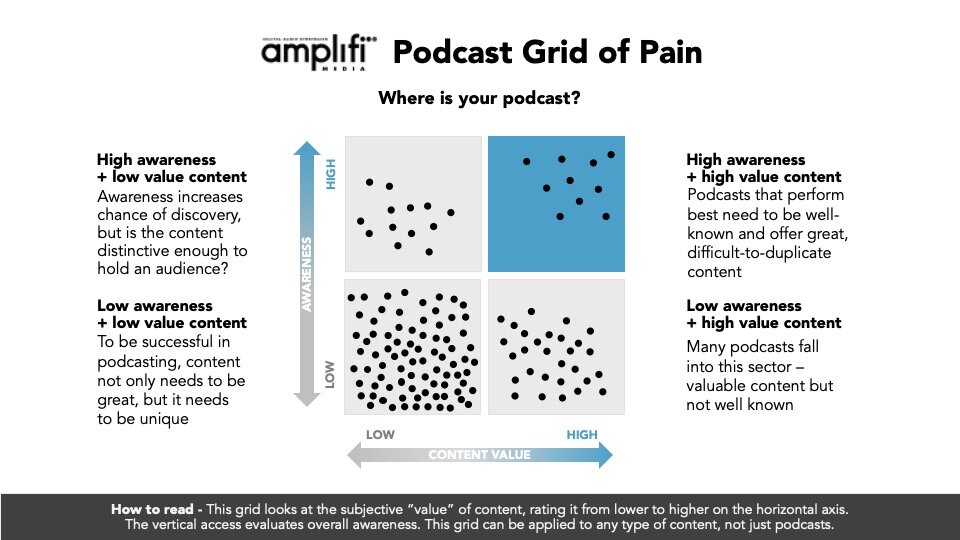
Steve Goldstein’s Amplifi Media works with media companies and podcasters in developing audio content strategies. Goldstein writes frequently at Blogstein, the Amplifi blog. Steve can be reached directly at 203-221-1400 or sjgoldstein-at-amplifimedia-dot-com.
Every day we’re engaged in conversations about the difficulties and frustrations of growing a podcast. Every Day. At Podcast Movement 2021, Edison’s Tom Webster talked about when podcasts plateau. Plateau is an elegant looking but intimidating word. In marketing, it roughly translates to ‘hit the wall.” Or worse. I’ll let you fill in the blank.
Tom discussed the importance of word-of-mouth and recommendations, suggesting that when they slow down, downloads do too. Even in a hi-tech world, a personal endorsement is a dynamic motivator. If you want people to evangelize your podcast, it can’t be “pretty good” or “fine.” Recommendations are the result of being exceptional, notable, shareable, and, as I’ve previously written about, findable. Buzz is hard. For every Ice Bucket challenge, there is, well, there is nothing. Which brings me to pain and the most challenging chart in all of podcasting.

Let’s break down what our Grid of Pain is all about and why it’s essential to land in the upper-right corner if you want to cut through and grow your audience.
Lower left – The Swarm
The lower-left quadrant, where you see the most dots, is where most podcasts live. These shows, as a group, are not distinctive, or not distinctive enough and don’t have much awareness. Recommendations made for content occupying the low-awareness/low-value block are probably slim. That’s a systemic issue. To put it another way, there is not a lot of chatter about the mediocre pizza place.
Upper left – “Hey Let’s do a Podcast”
The upper-left quadrant is where many with a social following fit. These are often podcasts where well-known people create undifferentiated content that opens with a bang and usually closes with a whimper. Many of these shows disappear as the audience dwindles, the stars/hosts become bored or learn how difficult it is to generate great content repeatedly.
Bottom right – The Hopefuls
The lower-right quadrant is where many wonderful podcasts end up. These are podcasts that deliver great and unique content but have low awareness. As a result, these pods need to work hard to get recommendations and generate awareness to grow and thrive.
Upper right – The Superstars
The upper-right quadrant is where everyone wants to be. Think of it as the box office win — the rarified air reserved for podcasts with high-value content (HVC) and high awareness. These are hits, and looking at the podcast charts, it’s a pretty steady group and hard to crack. This is where buzz, chatter and recommendations come more readily.
Not Every Podcast Is Poised For Greatness, And As They Say, Trees Don’t Grow To The Sky.
How to Use Amplifi’s Grid of Pain
If your podcast isn’t generating the recommendations or awareness needed for growth, it is worth diagnostically looking at this grid and assessing where things stand. Look inward and think about the topics and execution as well as other podcasts with similar content. Not every podcast is poised for greatness, and as they say, trees don’t grow to the sky.
For some podcasts, recommendations may be more episodic. Even with great shows such as NPR’s Fresh Air, some episodes prove more buzzworthy than others. Guests, subject matter and timeliness can make a difference.
A client recently asked me what kind of download traffic one should expect for a newly launched podcast. They bristled when I told them none. Zippo. Nada. Without the right megaphones, marketing, discoverability tactics, influencers, and word-of-mouth in place, it’s almost impossible to reach the holy grail of the upper-right quadrant. And while this is a podcast grid of pain, zooming out a little bit is a reminder that trying to get attention is really a tough thing to do, no matter the platform. We are getting pushed and pulled with new things to watch and listen to everywhere, which is why difficult-to-duplicate content performs better.
Is Your Content Truly Recommendable, Or Is It Just “Fine?”
Comedian Ellen DeGeneres levels the category of “fine dining.” A friend asks, “How was the restaurant?” The response; “It was fine.” “Fine” screams average. Average is getting crushed.
More and more, podcasts without a differentiated point of view, the right content or strategy, will experience the word plateau in the past tense, plateaued, which will force the tender question, is your content truly recommendable, or is it just “fine?”
Special thanks to David Lebow and Jimmy DeCastro
.
